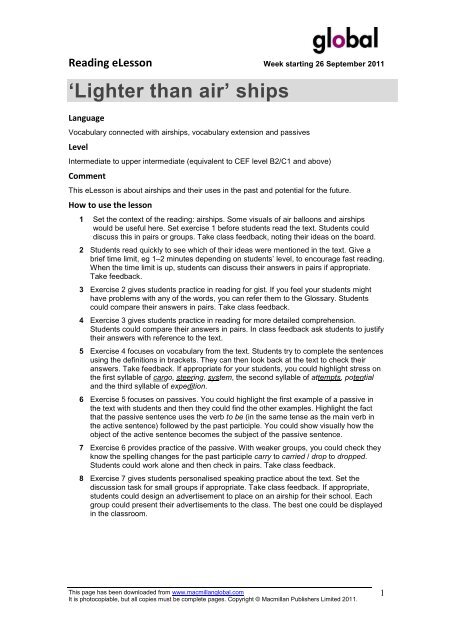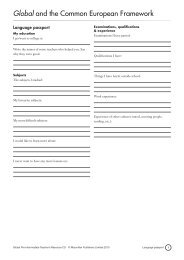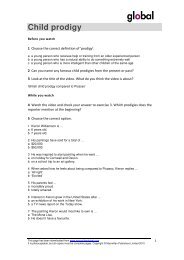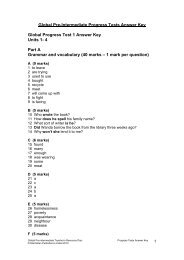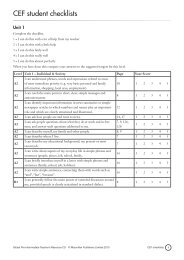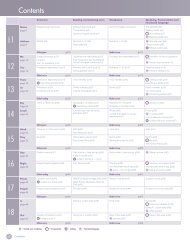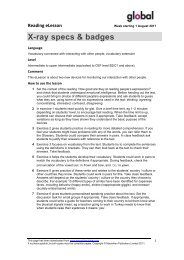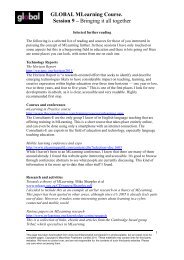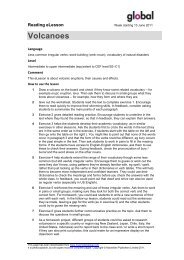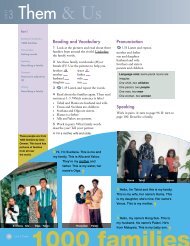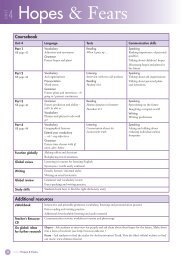Download Teacher's Notes - Global from Macmillan Education
Download Teacher's Notes - Global from Macmillan Education
Download Teacher's Notes - Global from Macmillan Education
- No tags were found...
Create successful ePaper yourself
Turn your PDF publications into a flip-book with our unique Google optimized e-Paper software.
Reading eLesson Week starting 26 September 2011‘Lighter than air’ shipsLanguageVocabulary connected with airships, vocabulary extension and passivesLevelIntermediate to upper intermediate (equivalent to CEF level B2/C1 and above)CommentThis eLesson is about airships and their uses in the past and potential for the future.How to use the lesson1 Set the context of the reading: airships. Some visuals of air balloons and airshipswould be useful here. Set exercise 1 before students read the text. Students coulddiscuss this in pairs or groups. Take class feedback, noting their ideas on the board.2 Students read quickly to see which of their ideas were mentioned in the text. Give abrief time limit, eg 1–2 minutes depending on students’ level, to encourage fast reading.When the time limit is up, students can discuss their answers in pairs if appropriate.Take feedback.3 Exercise 2 gives students practice in reading for gist. If you feel your students mighthave problems with any of the words, you can refer them to the Glossary. Studentscould compare their answers in pairs. Take class feedback.4 Exercise 3 gives students practice in reading for more detailed comprehension.Students could compare their answers in pairs. In class feedback ask students to justifytheir answers with reference to the text.5 Exercise 4 focuses on vocabulary <strong>from</strong> the text. Students try to complete the sentencesusing the definitions in brackets. They can then look back at the text to check theiranswers. Take feedback. If appropriate for your students, you could highlight stress onthe first syllable of cargo, steering, system, the second syllable of attempts, potentialand the third syllable of expedition.6 Exercise 5 focuses on passives. You could highlight the first example of a passive inthe text with students and then they could find the other examples. Highlight the factthat the passive sentence uses the verb to be (in the same tense as the main verb inthe active sentence) followed by the past participle. You could show visually how theobject of the active sentence becomes the subject of the passive sentence.7 Exercise 6 provides practice of the passive. With weaker groups, you could check theyknow the spelling changes for the past participle carry to carried / drop to dropped.Students could work alone and then check in pairs. Take class feedback.8 Exercise 7 gives students personalised speaking practice about the text. Set thediscussion task for small groups if appropriate. Take class feedback. If appropriate,students could design an advertisement to place on an airship for their school. Eachgroup could present their advertisements to the class. The best one could be displayedin the classroom.This page has been downloaded <strong>from</strong> www.macmillanglobal.comIt is photocopiable, but all copies must be complete pages. Copyright © <strong>Macmillan</strong> Publishers Limited 2011.1
Reading eLesson Week starting 26 September 2011Answer key1 Students' own ideas.21 para 52 para 23 para 64 para 35 para 431 F (airships have an engine and steering system)2 T3 F (airships are less dangerous because the gas used is non-explosive helium and if thereis a leak, it takes days for all the gas to leak out)4 F (planes can carry 13,000 litres of water / hybrid air vehicles could carry one million litres)5 T6 F (there are plans for hybrid air vehicles to do this in the future)41 steering system2 attempts3 cargo4 potential5 expedition5airships are being developedwas on 12 May, 1929, followed by a major expedition in 1931how will airships be used in the future?early airships were filledplanes are usedafter a fire has been put outHybrid air vehicles will be used61 were made2 were used3 was reached4 was made5 is carried6 will be filled7 will be dropped8 will be hired7 Students’ own answers / ideas.Related websitesThe following websites might be useful for either you or your students.http://www.newscientist.com/article/dn2425-gigantic-airships-aim-to-damp-forest-fires.htmlhttp://www.independent.co.uk/news/people/news/the-inventor--whos-putting-blimps-back-onthe-radar-2353673.htmlhttp://www.airships.net/lz127-graf-zeppelin/polar-flightThis page has been downloaded <strong>from</strong> www.macmillanglobal.comIt is photocopiable, but all copies must be complete pages. Copyright © <strong>Macmillan</strong> Publishers Limited 2011.2


